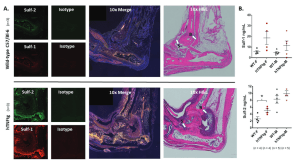In a recent paper, researchers have discovered and described a protein known as sulfatase-2 that may be a key role player in the pathology of rheumatoid arthritis (RA) (Figure 1). This finding helps researchers understand the mechanisms underlying the inflammation seeing in RA. Currently there is no cure, but these findings may lead to improved treatments of the disease.

Figure 1: Extracellular sulfatase levels are elevated in inflamed joint tissues and serum of a human TNF-transgenic mouse model of RA. Extracellular sulfatase protein levels were compared in human TNF-transgenic mice of the 3647 line (hTNFtg) and littermate wild-type (WT) C57BL/6 mice. A Murine Sulf-1 and Sulf-2 proteins were at qualitatively higher levels in ankle sections of hTNFtg mice as determined by fluorescence IHC. Images are shown with isotype-matched controls on the same tissue and slide. H&E images illustrate synovial hyperplasia and leukocyte infiltration, which are characteristic of hTNFtg mice. Bone (B) and synovial tissues (S) are labeled. B Murine Sulf-1 and Sulf-2 proteins in serum samples from hTNFtg and littermate WT mice were quantitated by ELISA. Data are presented as the mean ± SEM. *p < 0.05
RA is a chronic disease in which the immune system attacks the body’s own joint tissues. Tumor necrosis factor-alpha (TNF-α) is a common and major inflammatory marker driving RA and is the target of many therapies. Patients can develop resistant to treatments overtime; therefore new treatments are needed.
Investigating sulfatase-2 in synovial fibroblasts (cells which line the joints and lubricate them), the researchers removed the protein from one group of cells and stimulated the cells with TNF-α. They were able to show that the cells without sulfatase-2 showed reduced inflammation. This could open the field to new research into using the inhibition of sulfatase-2 to reduce RA symptoms.
Journal article: Siegel, R.J., et al., 2022. Extracellular sulfatase-2 is overexpressed in rheumatoid arthritis and mediates the TNF-α-induced inflammatory activation of synovial fibroblasts. Cellular & Molecular Immunology.
Summary by Stefan Botha










